You are here
Sholakzhideli petroglyphs.
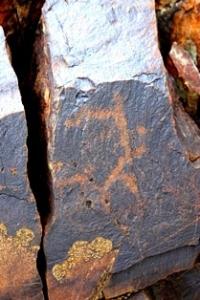
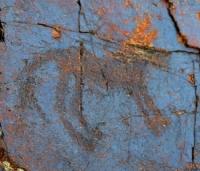
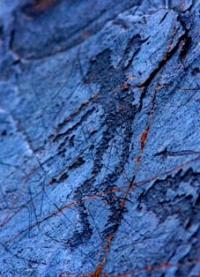
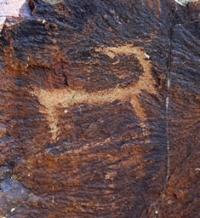
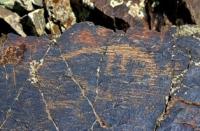
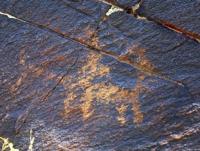
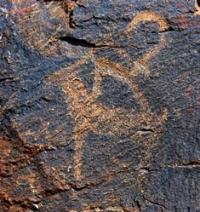
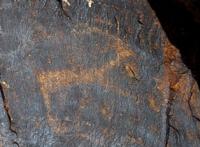
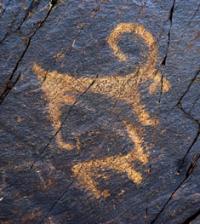
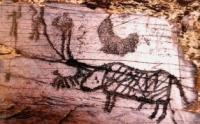
Petroglyphs Zhambyl province.
"The Kozhabala burial site on the north-eastern slope of Mount Sunkar is the most ancient explored site at Khantau. A total of 150 burials are represented by fenced rectangular or roundish stone structures."
Excavated graves yielded cremated remains and a body with ornate pottery and bronze jewelry (bracelets, pendants, bead necklaces). The burial site, dated to the XIIIth century BC, is attributed to the mixed type of sites of the Andronovo cultural and historical community common in the south of Saryarka and Western Semirechie"
Tours to petroglyphs of Kazakhstan.
Sholakzhideli Gorge is located in the Shu District of the Zhambyl Region, 5km east of Khantau Station on the western slope of the Khantau Mountains. The Low Khantau and Zhambyl Mountains form the northern end of the Chu-Ili Range.
That area is surrounded by almost impassable deserts (Moyinkum, Begapdala and Taukum), to the west, north, and east. For more than three millennia, it thus had a special significance in the system of interregional communications, cultural, economic, political ties and relations.
The routes historically connecting Eastern Europe and Western Siberia, Central Asia, Internal Tien Shan and China met there. Until the middle of the XIXth century, trade caravans from Bukhara and Tashkent stopped to rest before continuing their journey through the desert to the shores of the Balkhash and farther on to Irtysh and Tobol.
The strategic main road – Big Kalmy Road that connected the nomadic headquarters (urgu) of the rulers of the Dzhungarian Khanate and Tibet with the Volga Kalmyks-led from there to the Volga through the Kazakh Steppe. The Khantau archeological sites testify to the significance of the Semirechie area in Antiquity.
Research on Khantau archeological sites is incomplete. Some sites with petroglyphs were discovered in the 1970’s and 1980’s by geologists Medoev A.G., Volobuev V.-I., historians and regional ethnographers Zholdasbaev S. and Baybosynov K. Archeologist Ismagilov R.B. only excavated burial grounds dating to the Bronze Age in Kozhabala. The most researched type of site is still rock art. In 1994, a French-Kazakh Expedition (Francfort H.P. & Samashev Z.) surveyed petroglyphs in the Sholakzhideli Gorge.
In 2007 and 2009, an expedition from the KazSRI Nomads carried out archeological exploration in the Khantau Mountains and documented petroglyphs in the Zholakzhideli Gorge. They made a map of the surveyed area, indexed Sholakzhideli Canyon, photographed surfaces with petroglyphs, and made contact copies of some of them.
Khantau is a large mountain massif mainly consisting of granites and eruptive rocks. Several valleys are parallel along the south-western slope. The largest of them – Sunkarsay, Ulkentaldy, Sholakzhideli and Terekty – begin as wide water-drainage funnels and form deep and narrow gorges in their openings that served as an ideal environment for rock art galleries.
As a rule, dwelling sites of the Neolithic and later periods including the Middle Ages are located in the upper part of the valleys near the estuaries of small rivers and springs. Frequent discoveries of ornamented pottery made with a potter’s wheel point to the close ties of IXth and Xth centuries AD nomads with the settlements of non-migratory populations and cities in the Chu Valley.
Small groups of kurgans of early and medieval nomads were left in the piedmont area, but the largest cemeteries are concentrated in the southern foothills of Mount Sunkar. Groups of funerary fences built with 7/8 boulders stretch in a line along chains of kurgans.
Judging from their appearance, these fenced kurgan burial sites resemble Altai sites dated to the Pazyryk Culture of the Scythian Period. Ancient Turkic stone fences and statues were found in hill sites of intermontane areas.
The Kozhabala burial site on the north-eastern slope of Mount Sunkar is the most ancient explored site at Khantau. A total of 150 burials are represented by fenced rectangular or roundish stone structures.
Excavated graves yielded cremated remains and a body with ornate pottery and bronze jewelry (bracelets, pendants, bead necklaces). The burial site, dated to the 13th century BC, is attributed to the mixed type of sites of the Andronovo cultural and historical community common in the south of Saryarka and Western Semirechie.
As at other Bronze Age burials in the Chu-Ili Mountains (Tamgaly I, Oy-Dzhaylau III), the Kozhabala necropolis records the history of steppe tribes in Central Kazakhstan and all the way to the foothills of Tien Shan in the last third of the IInd millennium BC.
The most ancient petroglyphs in Khantau’s mountainous valleys are dated to the Bronze Age. They also include engravings very typical of the Northern Near Balkhash Area rock art by repertoire and style and Bronze Age petroglyphs common in other parts of Semirechie.
The most remarkable Khantau petroglyphs include engravings dating to the middle of the 1st millennium BC, most of which are unique or rare, specific to the Chu-Ili Mountains and belonging to the period of early nomads.
The largest location of petroglyphs in Khantau is Sholakzhideli. Most are concentrated on the right slope of a small canyon at the mouth of the valley. The rock massif is formed by alternating rows of erosion terraces that resemble high steps that make the canyon look like an antique theater.
All rocks are covered with “desert patina”, but horizontal surfaces, where most petroglyphs are carved, had the best qualities for rock art. Therefore, one can see the images only when ascending the slope or standing at the edge of a ledge. This is a specific feature of Sholakzhideli rock art that distinguishes it from all other known sites in the Khantau and Chu-Ili Mountains.
The canyon contains petroglyphs of the Bronze and Early Iron Ages, while the most ancient images cover only a few wide surfaces; the remaining surfaces were used by artists of the Saki Period.
Medieval petroglyphs and recarvings of ancient images are few, so most early engravings are in a good state of preservation. There are about 2,000 petroglyphs in all. Images of horses, bulls, camels and a chariot are dated to the Bronze Age; a two-wheeled chariot is shown schematically without draft animals.
They differ only slightly and were apparently created within one period. They also include several artfully carved images, thematically quite similar. A remarkable scene in the upper tier of the canyon is that of a battle between two stallions on their hind legs.
Petroglyphs of the Saki Period, in a majority in the canyon, are often carved on the same surfaces, while in some cases they overlap Bronze Age images. In general, the layer of petroglyphs is heterogeneous, with earlier and later series of images while some images are superimposed in some compositions.
Engravings of the Early Saki Animalistic style are characterized by a unique manner of depicting wild animals – herbivores and predators. However, the overall background of the gallery consists of a different pictorial tradition with some elements of animalistic style, but it loses the plasticity intrinsic to the Early Saki art and shows a noticeable prevalence of ornamental elements.
Contour images of animals, whose body frame is filled with various lines, scrolls, and other ornamental figures, are dominant. Laced animals clumsily overlap Bronze Age and Saki engravings, which shows a shift in the artistic traditions of the second half of the IInd millennium BC.
They include a unique image of a deer with tree-like antlers and shapes on its back that resemble wings. In general, this series of petroglyphs is similar to those found far in the north-east, in the art of the Tagarian tribes of the Middle Yenisei and Pazyryk Culture of the Altai as well as that of some other sites in the Chu-Ili Mountains (Anyrakay, Tamgaly) and in the Near Issyk Kul Area (Cholpon-Ata).
This said, the Sholakzhideli petroglyphs represent the largest series of drawings of this type in the Chu-Ili Mountains. Petroglyphs also include tamga-like signs of two types also found in other rock art locations in Central Asia (Altai, Tuva, and Mongolia).
Another rare category of engravings includes mirrors, on several sites scattered along the Chu-Ili mountains from Kulzhabasy in the south to Khantau in the north. Out of five mirrors with a straight protruding handle carved on one surface at Sholakzhideli, four are depicted with life-size proportions, shapes and sizes.
Their comparison with dated artifacts gives a probable age for the petroglyphs and indicates the historic and cultural contacts of early nomads in Semirechie, all the more as depictions of mirrors do not occur, for example, in the Dzhungarian Alatau.
At the same time, solar images of mirrors with protruding handles are known on sites of the Mountainous Altai (Kalbak-Tash). Thus, the engraved mirrors, together with other discoveries and sites in the Chu-Ili Mountains, reflect the special historical significance of this geographical region in the system of ancient communications through Western Semirechie.
Modern petroglyphs–lineage tamgas of Kazakhs of the Great Juz (Senior Horde nomads) of the Dulat tribe-were found in the Sholakzhideli and Zhideli Gorges in the vicinity of several dwelling sites dated to the last third of the XIXth century.
As in other areas of Semirechie, due to a scarcity of land, these signs certified lineage property rights for the most conveniently-located nomadic wintering grounds.
Geographic coordinates of the Hantau mountains: N44 ° 13'36.64 "E73 ° 55'05.03"
Authority:
“Rock Art Sites in Kazakhstan”. Alexey E. Rogozhinskiy.
Photos by
Alexander Petrov.







